The sizzle of the wok. That intoxicating aroma of garlic and ginger hitting hot oil. There’s something almost magical about making fried rice at home. I still remember my first attempt at chicken fried rice—a soggy, clumpy disaster that bore little resemblance to the fluffy, flavor-packed restaurant version. That was twenty years and thousands of woks of rice ago. Now? I could practically make it with my eyes closed.
Ever wonder why restaurant fried rice tastes so much better than homemade? I’m about to spill all the secrets that took me years to discover. This isn’t just another chicken fried rice recipe—it’s a foolproof method that’ll transform your homecooking game forever.
Ingredients & Substitutions
The Foundations
- 3 cups cooked jasmine rice, cold (preferably day-old)
- 2 tablespoons vegetable oil, divided
- 2 large eggs, lightly beaten
- 1 pound boneless, skinless chicken thighs, cut into ½-inch pieces
- 3 cloves garlic, minced
- 1 tablespoon fresh ginger, grated
- ½ cup carrots, diced small
- ½ cup frozen peas, thawed
- 3 green onions, thinly sliced (white and green parts separated)
- ¼ cup onion, finely diced
The Flavor Builders
- 3 tablespoons soy sauce (low-sodium preferred)
- 1 tablespoon oyster sauce
- 1 teaspoon toasted sesame oil
- ½ teaspoon white pepper
- 1 teaspoon sugar (optional)
- Salt to taste
The rice you choose matters tremendously. Jasmine rice brings a subtle fragrance that elevates the entire dish, but medium-grain Calrose works wonders too. Got dietary restrictions? Cauliflower rice can substitute, tho you’ll need to adjust your technique (more on that later). For a true authentic experience, nothing beats day-old rice—its moisture content is perfect for fried rice, preventing that dreaded mushy texture.
Chicken thighs are non-negotiable for me. They stay juicy and tender where breast meat might dry out. However, if your watching fat content, breast meat works fine—just be extra careful not to overcook it. Vegetarians can swap in firm tofu cut into small cubes and pan-fried until crispy, or tempeh for a nutty alternative.
The sauce components might seem simple, but they create magic together. If you’re soy-free, coconut aminos make an excellent substitute with a slightly sweeter profile. No oyster sauce? Fish sauce plus a pinch of sugar creates a similar umami depth. Missing that? Worcestershire sauce can work in a pinch—just use half the amount.
Step-by-Step Instructions
Preparing Your Canvas
First things first—please dont use freshly cooked rice. It’ll turn to mush faster than you can say “takeout menu.” Ideally, cook your rice the day before and refrigerate it overnight. In a rush? Spread freshly cooked rice on a baking sheet and pop it in the freezer for 15-20 minutes.
Break up any clumps in your cold rice using your fingers. Those individual grains are crucial for the perfect texture. Trust me, I’ve skipped this step before—big mistake! Each grain should stand proud and separate.
Prep all ingredients before heating your wok. Fried rice waits for no one, and the cooking process moves lightning-fast. I’ve burnt many a garlic clove by scrambling to chop something mid-cook.
The Cooking Dance
Heat 1 tablespoon of oil in a wok or large skillet over high heat until it’s just smoking. Pour in beaten eggs, swirling to create a thin layer. Let them set for about 10 seconds, then scramble quickly until just cooked but still moist. Remove and set aside.
Without washing the wok, add remaining oil and heat until shimmering. Add chicken pieces in a single layer and let them sear undisturbed for 1 minute. This creates that gorgeous caramelization that’s packed with flavor. Flip and cook until just done, about 2-3 minutes total. The chicken should be barely cooked through—it’ll continue cooking later.
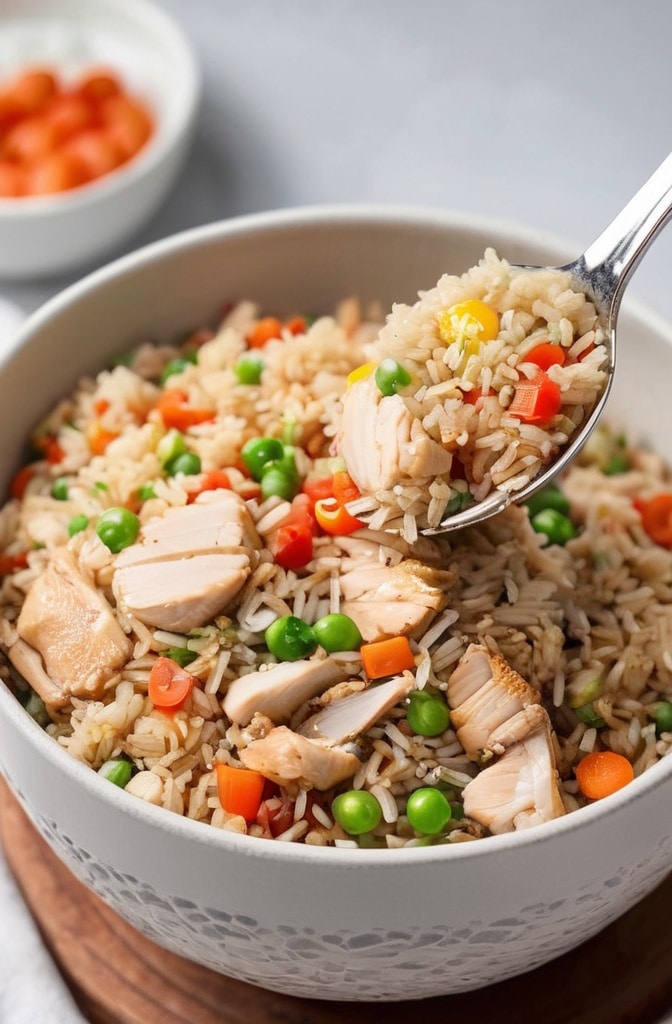
Lower heat slightly, add white parts of green onions, diced onion, garlic, and ginger. Stir-fry for 30 seconds until fragrant. Don’t let the garlic brown or it’ll turn bitter! A common mistake that’ll ruin your dish faster than anything else.
Toss in carrots and stir-fry for another minute. The key here is maintaining high heat while keeping everything moving. If your veggies start to burn rather than sear, your heat’s too high or your wok’s too dry.
Now for the main event—add the cold rice, breaking up any remaining clumps with your spatula. Spread it evenly across the wok surface, letting it make contact with the hot metal. This is where the magic happens! Let it sit for 30 seconds, then toss and repeat. This creates those coveted toasty rice kernels that define great fried rice.
After about 2 minutes of rice-frying, create a well in the center and pour your mixed sauces directly onto the hot wok surface. They should sizzle immedietly. Quickly toss everything together until the rice is evenly coated and fragrant.
Fold in the peas, cooked egg (breaking it into pieces), and green parts of onions. Toss for another minute until everything is heated through and well-combined.
The Final Touch
Taste and adjust seasoning—this is critical! Sometimes an extra splash of soy sauce or a pinch of salt makes all the difference. Finish with a drizzle of sesame oil off the heat—never cook with it, as heat destroys its delicate flavor.
Transfer to a serving dish immediately. Lingering in the hot wok will continue cooking your perfect rice, potentially taking it from perfect to pasty.
Cooking Techniques & Science
The “wok hei” (breath of the wok) is what gives restaurant fried rice its distinctive smoky flavor. This happens when cooking at extremely high temperatures—higher than most home stoves can achieve. To compensate, I use a cast-iron skillet sometimes instead of a wok. It retains heat better than standard woks and creates beautiful caramelization.
Why cold rice? Fresh rice contains excess moisture and starch on the surface, leading to clumping when fried. Refrigeration causes the starch molecules to crystallize through a process called retrogradation. This restructuring prevents the rice from sticking together during stir-frying. Science, baby!
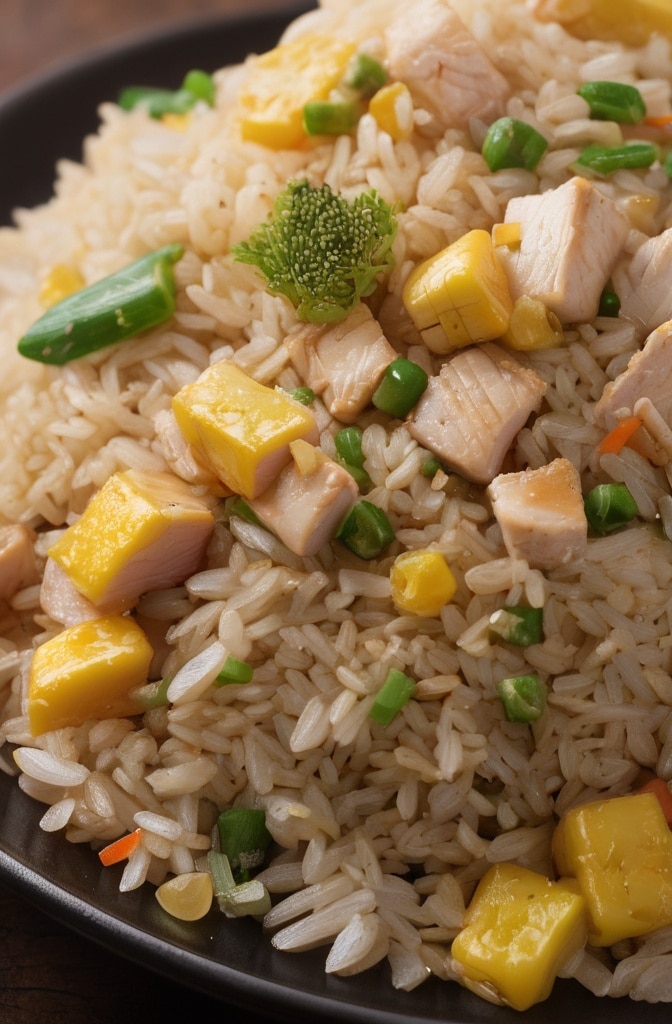
The secret to restaurant-quality chicken lies in “velveting”—a Chinese technique where meat is marinated briefly in a mixture of egg white, cornstarch, and rice wine before cooking. This creates a moisture-protecting shield around each piece. For a shortcut version, simply toss your chicken pieces with 1 teaspoon cornstarch and 1 teaspoon soy sauce before cooking.
High heat is non-negotiable for proper stir-frying. It creates a reaction called the Maillard effect—the same browning that makes toast so delicious. This chemical reaction between amino acids and reducing sugars creates hundreds of new flavor compounds. Without sufficient heat, you’re just steaming your ingredients.
Separating ingredients during cooking ensures each component is perfectly cooked. Eggs first, then meat, then aromatics and vegetables—this staged approach prevents overcooking delicate ingredients while ensuring everything reaches its optimal doneness.
Serving & Pairing Suggestions
Fried rice is traditionally served family-style in the center of the table, piping hot from the wok. For individual plating, try a molded approach: pack the rice firmly into a small bowl, then invert onto the plate for an elegant dome presentation. Garnish with additional sliced green onions, sesame seeds, or cilantro sprigs for a professional touch.
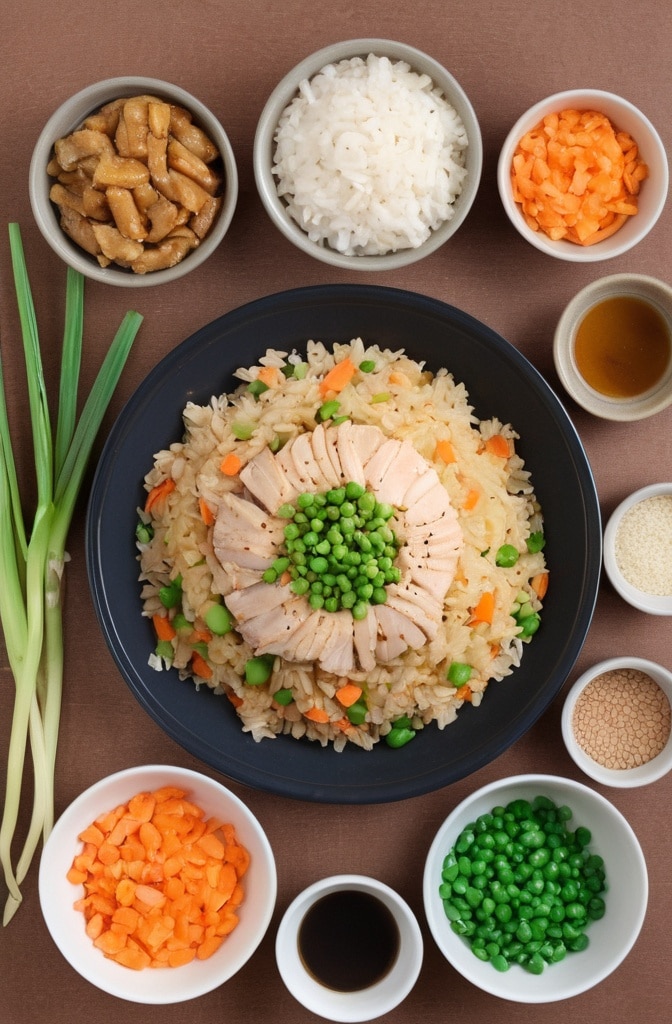
Contrary to popular belief, authentic Asian fried rice rarely comes with soy sauce on the side—it’s already perfectly seasoned! However, offering chili oil, Sriracha, or a small dish of Chinese black vinegar provides customizable heat and acidity for guests.
For a complete meal, pair with simple steamed vegetables dressed with a light sesame oil and rice vinegar dressing. The clean flavors balance the richness of the fried rice. Alternatively, a clear broth soup with mushrooms and tofu makes an excellent starter.
Beverage-wise, classic jasmine tea cuts through the richness beautifully. For alcoholic options, a crisp Japanese lager, dry sake, or even a glass of unoaked Chardonnay complements without overwhelming the subtle flavors.
Transform this side dish into an impressive main course by serving it inside a hollowed pineapple half for a Thai-inspired presentation, or wrapped in lotus leaves for special occasions.
Beyond the Basics: Advanced Variations
Once you master the basic technique, the variations are limitless. Try swapping the chicken for shrimp or char siu pork. Add diced pineapple and cashews for a tropical twist. Kimchi fried rice brings a fermented funk that’s absolutely addictive—just add chopped kimchi and a touch more sesame oil.
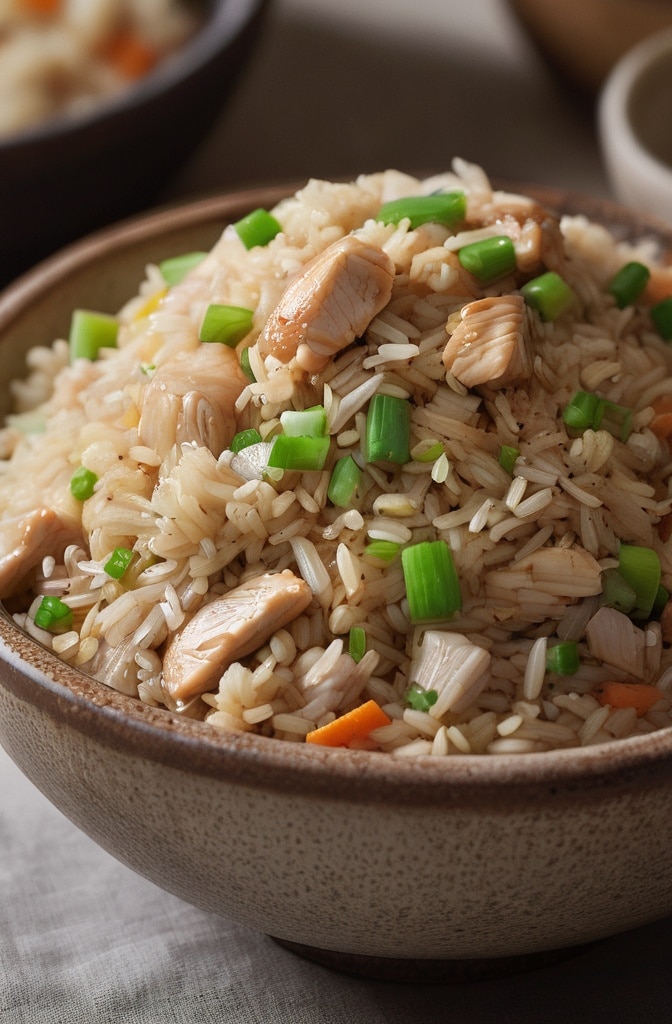
For a Japanese-inspired version, mix in a tablespoon of furikake seasoning and top with a fried egg with a runny yolk. The creamy yolk creates a luscious sauce when mixed with the hot rice.
Thai basil fried rice requires just a handful of Thai basil leaves added at the very end, but transforms the entire profile with its anise-like fragrance. Add some bird’s eye chilies if you dare.
Want to go upscale? Black truffle fried rice is having a moment in high-end Asian fusion restaurants. A tiny drizzle of truffle oil and some finely chopped mushrooms elevates this humble dish to dinner party status.
Troubleshooting Common Issues
Soggy rice? You probably used fresh, hot rice. Spread it on a baking sheet and place in the freezer for 15 minutes to dry it out before trying again.
Rice sticking to the wok? Your heat isn’t high enough or you’re overcrowding the pan. Work in batches if needed, and make sure your wok is properly seasoned.
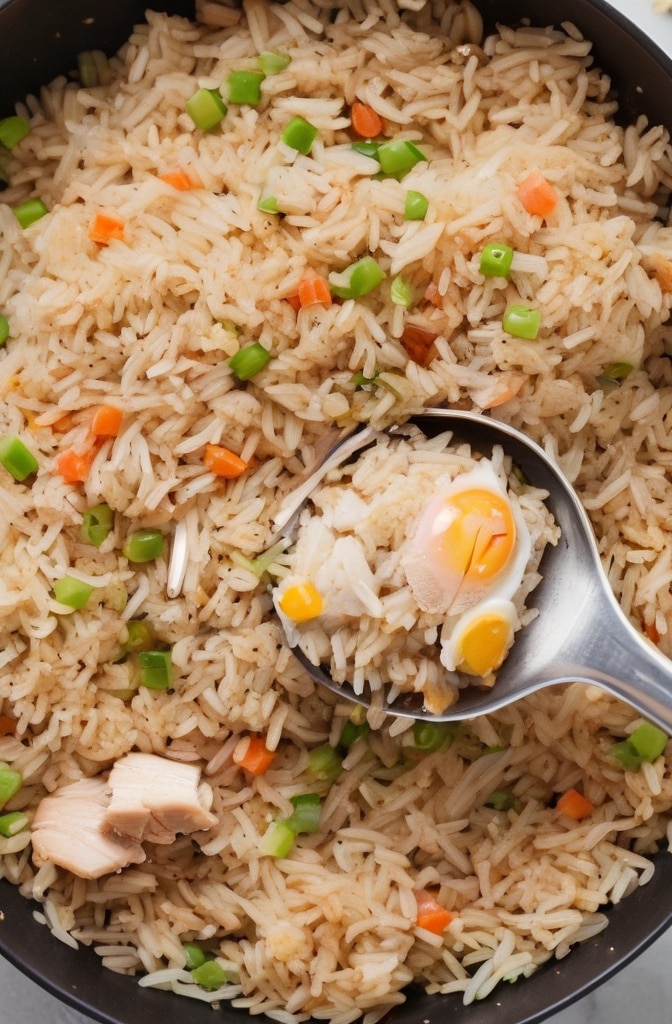
Bland results? Don’t be shy with seasonings. The rice absorbs a lot of flavor, so what might seem like enough sauce in the wok can taste muted on the plate. Also, check if your soy sauce is past its prime—it does lose potency over time.
Burning ingredients? Your heat is too high or you’re not moving things fast enough. Have everything prepped and within arm’s reach so you can work quickly and adjust heat as needed.
Eggs too rubbery? You’re overcooking them. They should barely set before being removed from the wok. They’ll finish cooking when added back to the rice later.
Mushy vegetables? Add denser vegetables (like carrots) earlier and delicate ones (like peas) later. And remember—always err on the side of undercooked for veggies in fried rice.
Conclusion
Great chicken fried rice isn’t just about following a recipe—it’s about understanding the principles behind it. The quality of your ingredients, the heat of your wok, the sequence of cooking—they all contribute to that restaurant-quality result we crave.
What makes this recipe special is its balance: simple enough for a weeknight dinner, yet complex enough in flavor to satisfy the most discerning palate. Master this technique, and you’ve gained not just a recipe but a cooking philosophy applicable across countless Asian dishes.
Remember that perfect fried rice is personal. Maybe you like it a bit wetter with more sauce, or perhaps you prefer it drier with more caramelized bits. That’s the beauty of cooking—once you understand the fundamentals, you can adapt to your own preferences.
So heat that wok, break out the chopsticks, and prepare to ruin takeout fried rice for yourself forever. Because once you taste homemade chicken fried rice done right, there’s simply no going back.
Frequently Asked Questions?
Can I use freshly cooked rice instead of day-old rice?
While day-old rice produces the best texture, you can use fresh rice in a pinch. Spread it on a baking sheet to cool completely, then refrigerate for 30 minutes or freeze for 15 minutes to remove excess moisture before using.
Why is my fried rice clumping together?
This typically happens when using warm or freshly cooked rice. The excess moisture and surface starch cause the grains to stick together. Always use thoroughly chilled rice and break up any clumps before adding it to the wok.
How can I make this recipe gluten-free?
Simply substitute regular soy sauce with tamari or certified gluten-free soy sauce, and ensure your oyster sauce is also gluten-free (or use a gluten-free fish sauce with a pinch of sugar instead).
What’s the best way to store leftovers?
Store leftover fried rice in an airtight container in the refrigerator for up to 3 days. When reheating, sprinkle a few drops of water over the rice before microwaving to help restore moisture, or better yet, quickly reheat in a hot skillet with a touch of oil.
Can I prepare any components ahead of time?
Absolutely! Cook the rice 1-2 days ahead and refrigerate. You can also pre-chop all vegetables and chicken and store them separately in the refrigerator. The actual stir-frying should be done just before serving for best results.
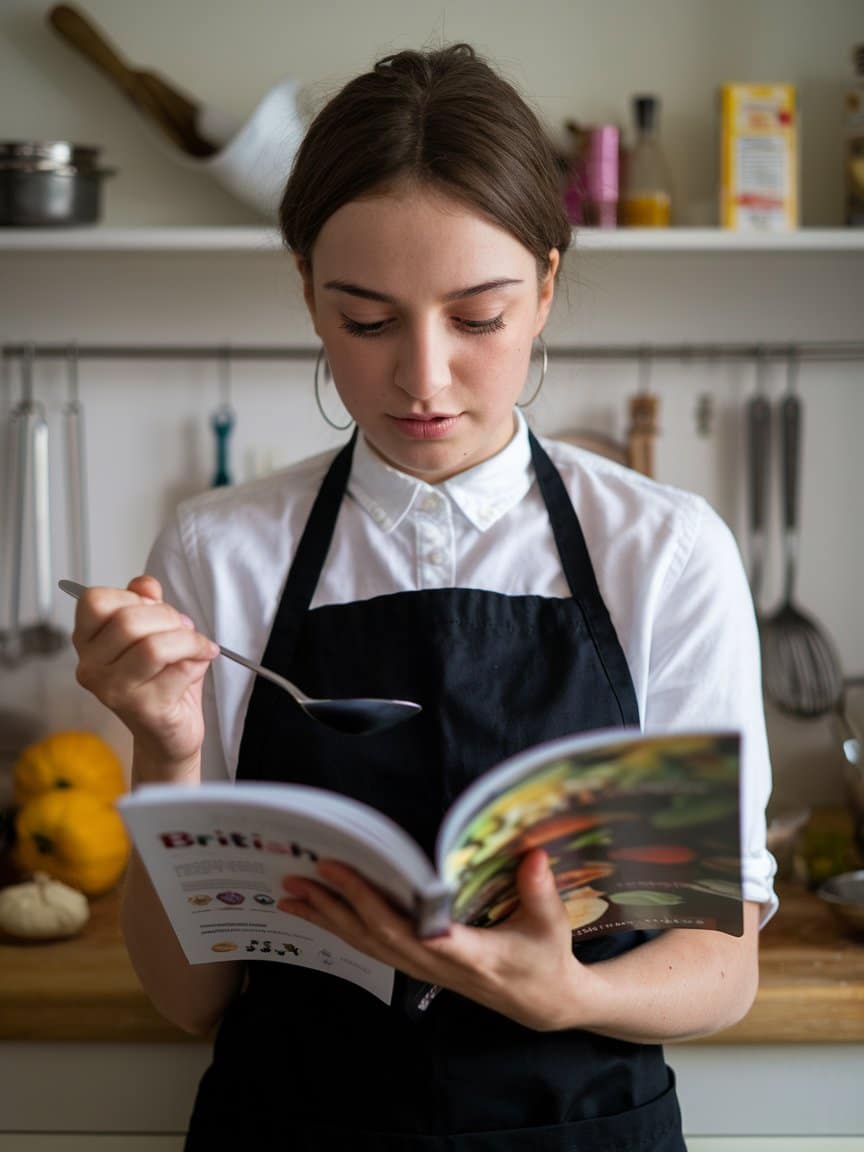
Veronica is a passionate food enthusiast with over three years of experience in exploring and writing about diverse cuisines. Her expertise lies in reviewing restaurants, sharing creative recipes, and discovering the latest food trends. As the voice behind FoodieRecap.com, Anju brings fresh perspectives and culinary insights to her audience.
